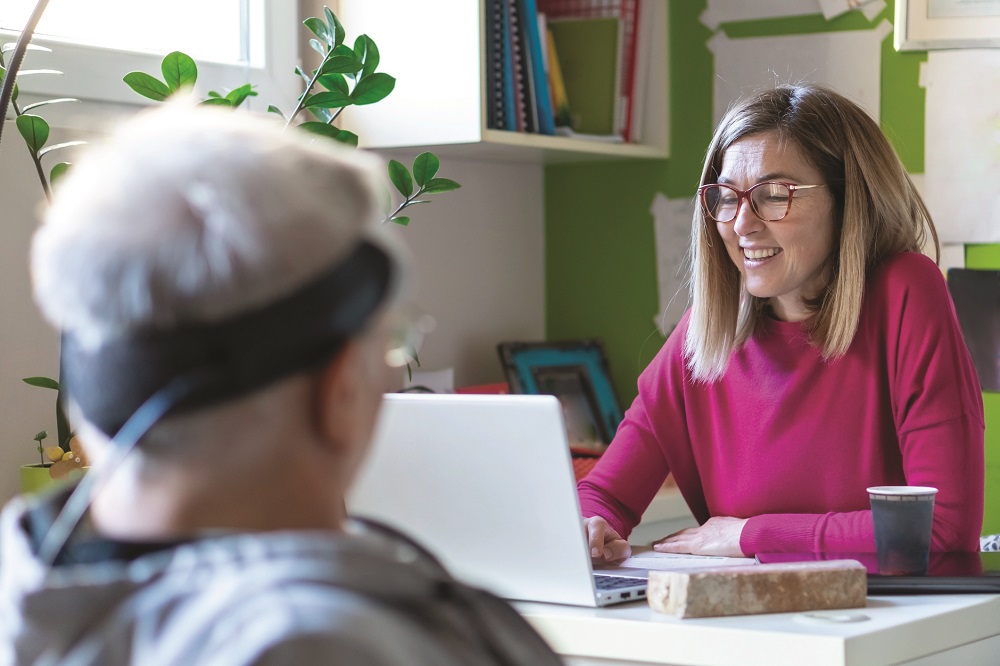You might be surprised to learn just how effective the mind-body practice of biofeedback is and how much scientific evidence there is to support that effectiveness for conditions ranging from stress to anxiety, high blood pressure, and even incontinence. You can learn how to do it at home after just a few sessions with a practitioner or, in some situations, completely on your own with a home biofeedback unit and/or an app.
Demystifying biofeedback
Biofeedback was developed in the 1960s. It draws from psychology, neurophysiology, cybernetics (the field of systems science) and medicine. Scientists were able to demonstrate through the use of an EEG machine that people had the ability to change their brain waves and state of being. The machine provided visuals of brain waves and showed that by using simple techniques, participants were able to reduce beta waves, which indicate alertness or agitation, and increase alpha waves, which indicate a more relaxed state. Over the years, the use of biofeedback has expanded to measuring not only brain waves, but also many other common physiologic changes you’re likely to experience when under stress or when living with a stress-related condition. These changes include a racing heart, rapid breathing, gastrointestinal cramps, muscle tension, and cold hands—reactions that occur when your sympathetic nervous system is in overdrive.
Biofeedback allows you to go beyond just feeling these reactions: It uses equipment that allows you to see them in action. Sensors placed on your body relay that activity to a monitor, giving you clear visuals of what’s happening inside your body.
This feedback gives you a greater sense of self-awareness and, coupled with biofeedback techniques, such as focused breathing, guided imagery, and progressive muscle relaxation, enables you to engage your parasympathetic nervous system—the counterbalance to the sympathetic nervous system—and get back to a more normal state.
Because you can see in black and white (or more accurately a variety of colors on the monitor) the effect the techniques are having, you know for sure when your efforts are working and you quickly learn how much effort you need to make. After a few sessions plus practice on your own, you may be able to achieve your desired results without the equipment.
Biofeedback in action
Biofeedback sensors can be applied to different parts of the body based on the health condition you’re facing and the goal you’re trying to achieve. For instance, electromyography biofeedback sensors measure muscle tension and thermal biofeedback sensors measures skin temperature. There are even sensors to detect sweat gland activity.
One of the most widely used forms of biofeedback is heart rate variability, or HRV, biofeedback, which can help with anxiety, depression, heart disease, high blood pressure, fibromyalgia, and musculoskeletal pain disorders. It focuses primarily on breathing. For instance, if you’re taking 13 or 14 breaths per minute, the goal might be to lower that number to six. That, in turn, lowers your heart rate. After four to eight sessions, many people are able to do it on their own.
When to consider biofeedback
Here’s more on some of the conditions biofeedback has been shown to help:
Stress and stress-related chronic illnesses. If you experience everyday stress but don’t need a psychotherapy practitioner to manage a mental-health issue, biofeedback is something you can do on your own.
For instance, HeartMath combines a sensor and smartphone app to show you how to change your heart rhythm pattern to decrease stress. More than 20 years ago, the FDA approved the home biofeedback device Resperate to decrease stress and lower blood pressure. Available without a prescription, it teaches you slow, deep breathing.
Incontinence. Among chronic physical conditions, forms of urinary and bowel incontinence worsened by stress often respond to biofeedback. A trained practitioner will show you how to use it to focus attention on pelvic floor muscles (the same target as Kegel exercises), among other techniques.
Anxiety. Many people who seek psychotherapy for anxiety and other mental health conditions do well with biofeedback. It may be part of a comprehensive treatment plan that includes cognitive behavioral therapy.
Pain. If you’re tense because of back pain or feel pain from an injury, biofeedback can help you relax and in turn reduce your discomfort. It’s not going to correct an underlying medical problem, but it can help you manage your reaction to the problem.
High blood pressure (HBP). Blood pressure control was one of the earliest subjects of biofeedback research. It won’t help if your HBP is due to salt sensitivity (dietary changes are needed for that), but it can assist with controlling what’s called essential HPB—when the cause is unknown.
Headache. Biofeedback is a very useful adjunct to medication therapy. Since rescue medications are limited to two or three times a week, you want to save them for true migraines. Biofeedback can quickly help you recognize if the pain you’re feeling is indeed a migraine or a headache brought on by food, stress, or another trigger. If it brings relief, you can be fairly sure it’s not a migraine. And if it doesn’t help, you still have time to take that rescue medication.
Raynaud’s disease. If you have this autoimmune disease, characterized by cold extremities, biofeedback can help you raise the temperature of your hands and feet, which can sometimes fall to as low as 80°F despite having a normal internal temperature of 98°F.
ADHD, PTSD, and other brain-related conditions. Research has shown that EEG biofeedback with sensors placed on the scalp to monitor brain waves can help many people, children included.
Finding a practitioner
The Association for Applied Psychophysiology & Biofeedback at www.aapb.org has an excellent search tool to help you find a certified practitioner near you.


